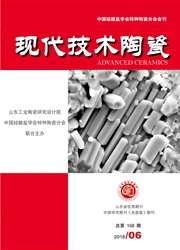

 中文摘要:
中文摘要:
采用固相反应法和柠檬酸-EDTA法制备了具有单一Aurivillius结构的Bi_2Cu_(0.1)V_(0.9)O_(5.35-δ)陶瓷样品,采用扫描电镜研究了陶瓷样品的显微结构,采用交流阻抗谱法研究了陶瓷样品在升/降温循环过程中的氧离子导电性能。结果表明,陶瓷样品的显微结构对升/降温循环过程中的氧离子导电行为有显著的影响。与采用固相反应法制备的大晶粒陶瓷样品相比,采用柠檬酸-EDTA法制备的陶瓷样品具有晶粒细小均匀的显微结构,能够有效抑制在升/降温循环过程中陶瓷样品氧离子总电导率的热滞现象。
 英文摘要:
英文摘要:
Bi_2Cu_(0.1)V_(0.9)O_(5.35-δ) ceramics with a pure Aurivillius phase were produced by the conventional solid-state reaction method and a citrate-EDTA method, respectively. The microstructure of the ceramic specimens was checked by scanning electron microscopy(SEM) and the oxygen-ion conductivity in a heating/cooling cycle was inspected by alternating current(AC) impedance spectroscopy. The results indicate a significant role of the microstructure in determining the oxygen-ion conductivity in heating/cooling cycle. Compared with the coarse-grained specimens prepared by the solid-state reaction method, the ceramic specimens derived from the citrate-EDTA method showed a fine-grained microstructure and a fairly good consistence in oxygen-ion conductivity in heating/cooling cycle without a remarkable hysteresis.
 同期刊论文项目
同期刊论文项目
 同项目期刊论文
同项目期刊论文
 期刊信息
期刊信息
